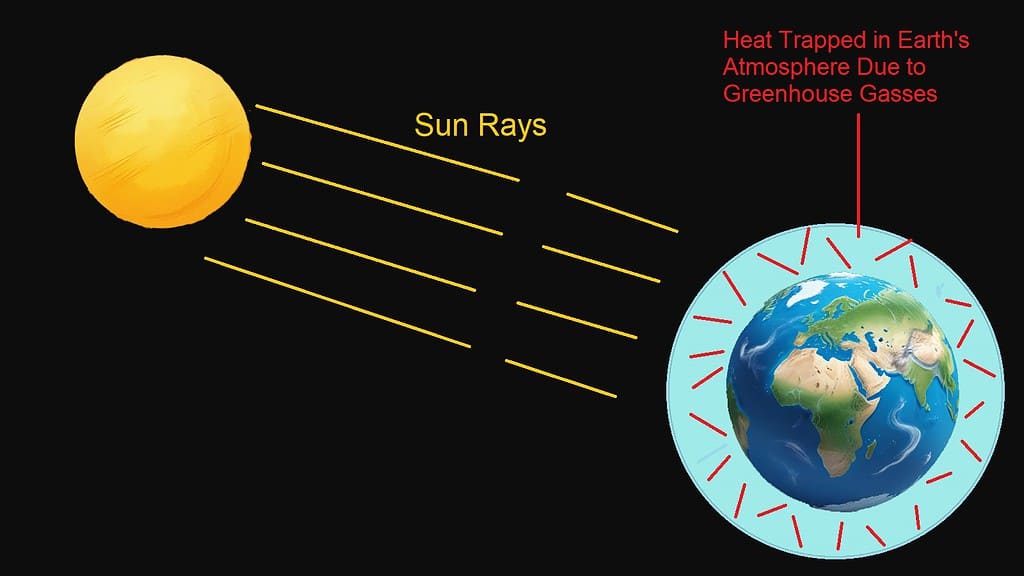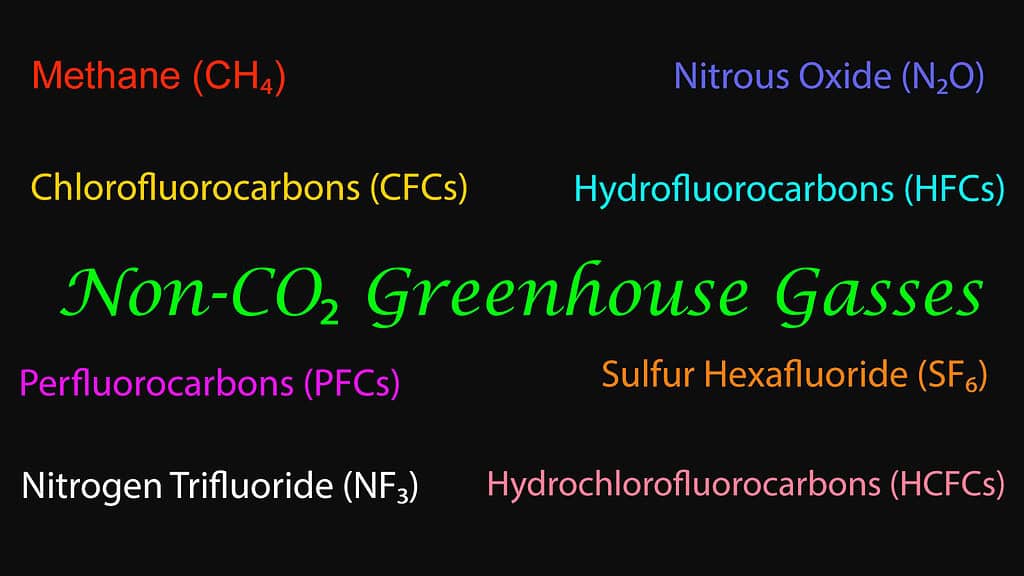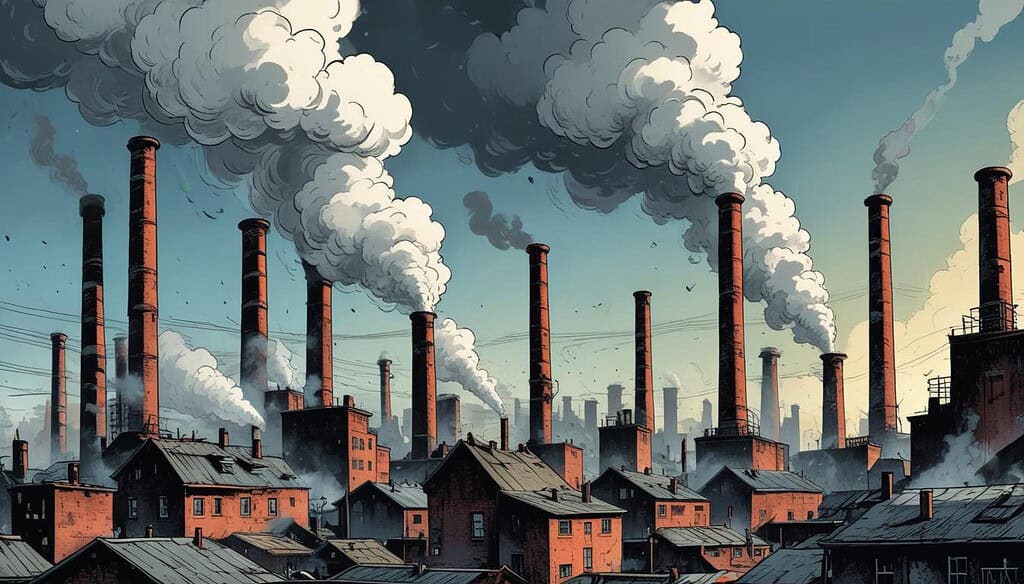Table of Contents
What Are Non-CO₂ Greenhouse Gasses

Non-CO₂ Greenhouse Gasses are a vital part of understanding the broader dynamics of climate change and atmospheric science. Unlike carbon dioxide, which often dominates discussions about global warming, a range of other gases significantly contributes to trapping heat and altering Earth’s energy balance. These gases, though sometimes emitted in smaller quantities, have a unique set of characteristics that make them potent climate agents.
Each gas, from methane and nitrous oxide to a suite of synthetic chemicals used in industrial processes, adds to the greenhouse effect in distinct ways, often with varying atmospheric lifetimes and chemical properties. Methane, for example, is a primary component of natural gas and results from both natural processes, like decomposition in wetlands, and human activities, such as agriculture and energy production. Nitrous oxide, frequently released from agricultural soils and industrial activities, also plays a critical role in the greenhouse effect.
Non-CO₂ Greenhouse Gasses include a wide array of fluorinated gases, such as hydrofluorocarbons (HFCs), perfluorocarbons (PFCs), and sulfur hexafluoride (SF₆). These are often used in refrigeration, air conditioning, and electrical insulation. While their concentrations in the atmosphere may be lower compared to more common greenhouse gases, their potency and persistence mean that even minimal releases can have a disproportionate warming effect.
Additionally, gases like ozone, which is both a natural and man-made greenhouse gas, contribute to warming while playing a complex role in atmospheric chemistry. Non-CO₂ Greenhouse Gasses do not only impact temperature but also influence weather patterns, cloud formation, and precipitation. These gases are essential components of the atmosphere, interacting with radiation in ways that can amplify warming or alter global energy flows.
Given their importance, studying Non-CO₂ Greenhouse Gasses is crucial for developing effective climate strategies. This requires addressing emissions from various sectors, understanding natural sources, and implementing international measures to manage these gases. While the sources and impacts of these gases vary, efforts to reduce them are often linked to sustainable practices and technological innovations. Monitoring and managing Non-CO₂ Greenhouse Gasses have become essential aspects of global climate agreements, highlighting the need for comprehensive action. Understanding these gases’ roles in the Earth’s climate system provides a more complete picture of global warming, emphasizing the importance of addressing all contributors to atmospheric change.
Some Non-CO₂ Greenhouse Gasses Can Be Worst Than CO₂

While carbon dioxide is often highlighted as the primary greenhouse gas fueling climate change, some Non-CO₂ Greenhouse Gasses can have far more severe impacts on global warming, especially when considering their potency in heat retention. These gases have a much higher global warming potential, meaning they are far more efficient at trapping heat in the atmosphere over specific timeframes.
Methane, for instance, is a key example. Though it has a relatively short atmospheric lifespan, its ability to absorb and hold heat is significantly greater, making it a potent driver of short-term warming. Emissions of methane stem from sources like livestock, landfills, and the oil and gas sector, and its presence in the atmosphere is a critical concern for climate scientists.
Similarly, nitrous oxide stands out among Non-CO₂ Greenhouse Gasses due to its long-lived nature and exceptionally high warming impact. Released primarily through agricultural practices and some industrial processes, nitrous oxide not only accelerates global warming but also poses additional risks by depleting the ozone layer. This dual threat intensifies the need for action to manage and reduce nitrous oxide emissions worldwide.
Synthetic gases, such as hydrofluorocarbons, perfluorocarbons, and sulfur hexafluoride, are yet another category of Non-CO₂ Greenhouse Gasses that can be more damaging than carbon dioxide. These man-made gases are engineered for specific applications, such as in refrigeration and fire suppression systems, but their heat-trapping capacity is astronomically higher. Some of these gases can remain in the atmosphere for thousands of years, continuously contributing to the greenhouse effect long after they have been emitted.
The danger posed by these gases is further amplified by their resilience and the difficulty in removing them from the atmosphere. Even minimal emissions of certain Non-CO₂ Greenhouse Gasses can have an outsized impact, making them critical targets in climate mitigation efforts. As nations work to curb overall greenhouse gas emissions, addressing these powerful agents becomes a matter of both urgency and precision.
Strategies to reduce their presence in the atmosphere often require specialized technology and global cooperation. The challenge lies in balancing human activity and industrial growth while ensuring that these high-impact gases do not undermine climate stabilization goals. Understanding and mitigating the effects of Non-CO₂ Greenhouse Gasses is crucial for making meaningful progress in the fight against climate change.
8 Non-CO₂ Greenhouse Gasses That Cab Be Worst Than CO₂

1. Non-CO₂ Greenhouse Gasses: Methane (CH₄)
Methane is one of the most significant Non-CO₂ Greenhouse Gasses contributing to global warming, and its impact is considerable due to its potent heat-trapping abilities. It originates from various natural and human-related sources. Wetlands, for instance, naturally emit methane through the anaerobic decomposition of organic matter, a process that occurs in oxygen-depleted environments. In contrast, human activities, particularly in agriculture, are substantial contributors.
Livestock, such as cattle, release methane during digestion, and rice cultivation emits methane as bacteria in flooded fields decompose organic material. Additionally, the energy sector is a major source, with methane released during the extraction, processing, and transportation of oil and natural gas. Landfills also contribute significantly, as decomposing organic waste produces methane, which escapes into the atmosphere if not properly managed.
What makes methane stand out among Non-CO₂ Greenhouse Gasses is its exceptional global warming potential (GWP). Over a 20-year period, methane has a GWP many times higher than that of carbon dioxide, which means it can trap a vast amount of heat in a short timeframe. This is particularly concerning because methane contributes to rapid warming that can destabilize weather patterns and accelerate climate change impacts. Methane’s relatively short atmospheric lifespan, approximately 12 years, means it does not linger as long as CO₂. However, its intense heat-absorbing capacity during that period makes it a formidable climate agent.
Moreover, when methane breaks down, it converts into carbon dioxide and water vapor, continuing to affect the climate, albeit in a diminished form. The urgency of addressing methane emissions is clear, as mitigating these emissions could significantly slow near-term global warming. Yet, the challenge lies in managing the numerous and diverse sources, which require a combination of policy measures, technological innovations, and agricultural practices tailored to minimize methane release.
2. Non-CO₂ Greenhouse Gasses: Nitrous Oxide (N₂O)
Nitrous oxide, another key Non-CO₂ Greenhouse Gas, poses a significant threat to the climate due to its long atmospheric lifespan and substantial global warming potential. It remains in the atmosphere for over 100 years, meaning that each molecule of nitrous oxide continues to contribute to warming for a century or more.
The primary sources of nitrous oxide emissions are agricultural activities, particularly the use of nitrogen-based fertilizers. When farmers apply these fertilizers to crops, soil microbes convert some of the nitrogen into nitrous oxide, which then escapes into the atmosphere. This natural microbial process, known as nitrification and denitrification, is a significant factor driving nitrous oxide emissions. In addition to agriculture, nitrous oxide is emitted during certain industrial processes and from the combustion of fossil fuels. Wastewater treatment and livestock management are also sources, as microbial activity in manure generates this powerful greenhouse gas.
Among Non-CO₂ Greenhouse Gasses, nitrous oxide is especially concerning due to its dual impact. Not only does it contribute directly to the greenhouse effect, but it also plays a role in depleting the ozone layer. The ozone layer, situated in the stratosphere, protects life on Earth by filtering out harmful ultraviolet radiation. When nitrous oxide rises into the stratosphere, it breaks down and releases nitrogen oxides, which react with ozone molecules, causing the ozone layer to thin. This has a cascading effect: a thinner ozone layer allows more UV radiation to reach the Earth’s surface, which exacerbates global warming and disrupts ecosystems.
The enduring nature of nitrous oxide makes it a formidable challenge in climate mitigation. Reducing emissions requires coordinated efforts, particularly in agriculture, where improved fertilizer management and soil conservation practices can make a difference. Industrial sectors must also adopt cleaner technologies to minimize nitrous oxide emissions. Despite these challenges, targeted strategies to curb nitrous oxide are essential to achieving long-term climate stability.
3. Non-CO₂ Greenhouse Gasses: Chlorofluorocarbons (CFCs)
Chlorofluorocarbons, synthetic chemicals developed for use in refrigeration, air conditioning, and aerosol propellants, are another group of Non-CO₂ Greenhouse Gasses that have left a lasting impact on the environment. Although the use of CFCs has been largely phased out under international agreements like the Montreal Protocol, their effects persist due to their long atmospheric lifetimes. CFCs are entirely human-made and do not occur naturally, which emphasizes the significant influence of industrial activities in shaping atmospheric conditions.
Once released, CFCs can remain in the atmosphere for several decades, continuously contributing to the greenhouse effect. Their high global warming potential means that even small quantities can trap large amounts of heat, exacerbating climate change. Additionally, CFCs have a well-documented impact on the ozone layer, which is crucial for blocking harmful ultraviolet radiation from reaching the Earth’s surface.
The ozone-depleting properties of CFCs make them particularly destructive as Non-CO₂ Greenhouse Gasses. When chlorofluorocarbons (CFCs) ascend to the stratosphere, they undergo decomposition due to solar radiation, which results in the release of chlorine atoms. These chlorine atoms then react with ozone molecules, depleting the ozone layer and allowing more UV radiation to penetrate the Earth’s atmosphere. This not only accelerates global warming but also has adverse effects on human health, such as increased risks of skin cancer and cataracts, and disrupts ecosystems, particularly marine life.
The warming effect of CFCs continues even as their concentrations slowly decrease, given their persistence in the atmosphere. The successful reduction of CFC emissions through the Montreal Protocol highlights the power of international cooperation in addressing climate challenges. However, the legacy of these gases remains a reminder of how human-made chemicals can have enduring environmental impacts. Continued efforts are necessary to ensure that alternative substances used in refrigeration and other industries do not replicate the harmful effects of CFCs.
4. Non-CO₂ Greenhouse Gasses: Hydrofluorocarbons (HFCs)
Hydrofluorocarbons are another class of Non-CO₂ Greenhouse Gasses that play a significant role in global warming. Developed as substitutes for ozone-depleting substances like CFCs and hydrochlorofluorocarbons (HCFCs), HFCs are widely used in refrigeration, air conditioning, and as propellants.
While HFCs do not deplete the ozone layer, their global warming potential remains alarmingly high. These gases are designed to have a shorter atmospheric lifespan compared to their predecessors, but they still retain a considerable capacity to trap heat. As a result, the widespread use of HFCs has contributed significantly to the greenhouse effect, with growing concerns over their impact as the demand for cooling systems increases globally. Developing regions, in particular, are seeing a surge in the use of air conditioning and refrigeration, which has led to a corresponding rise in HFC emissions.
The threat posed by HFCs as Non-CO₂ Greenhouse Gasses lies in their efficiency in trapping heat. Some HFCs have a global warming potential thousands of times greater than that of carbon dioxide, making even small emissions highly impactful. This makes the management and reduction of HFC emissions a crucial component of climate change mitigation strategies. The Kigali Amendment to the Montreal Protocol has been instrumental in initiating a global phase-down of HFCs, aiming to curb their impact while encouraging the adoption of climate-friendly alternatives.
However, this transition presents challenges, as it requires significant investment in new technologies and the development of environmentally safer refrigerants. Innovations such as natural refrigerants and more efficient cooling systems are being explored to reduce reliance on HFCs. The challenge is striking a balance between the need for modern refrigeration and air conditioning and the imperative to minimize environmental harm. Reducing the use of HFCs is a vital step in achieving broader climate goals and ensuring that advancements in comfort and technology do not come at the expense of the planet.
5. Non-CO₂ Greenhouse Gasses: Perfluorocarbons (PFCs)
Perfluorocarbons are a major category within the realm of Non-CO₂ Greenhouse Gasses. These synthetic compounds are primarily produced during industrial activities, notably in aluminum production and the manufacturing of semiconductors. PFCs are colorless, odorless, and chemically stable, which contributes to their exceptional longevity in the atmosphere. Their atmospheric lifetime can range from thousands to tens of thousands of years, making them particularly enduring climate pollutants.
This extreme persistence means that once PFCs are released, they continue to trap heat and contribute to global warming for millennia. The global warming potential of PFCs is immense, with some of these gases having thousands of times more heat-trapping capacity than carbon dioxide. Their potency comes from the strong carbon-fluorine bonds that are nearly impossible to break down naturally, resulting in a prolonged impact on the Earth’s climate.
PFC emissions are of particular concern because they are challenging to mitigate. Unlike other greenhouse gases that may have multiple sources, PFC emissions are often tied to specific industrial processes, making them harder to control without significant technological advancements. The aluminum industry, for example, generates PFCs during the electrolytic reduction process used to extract aluminum from bauxite. These emissions occur when the electrical current used in the process becomes unstable, a situation that is difficult to predict and prevent.
Semiconductor manufacturing is another key source, as PFCs are used in plasma etching and cleaning chambers. The microelectronics industry relies on these gases for their chemical inertness and effectiveness in etching intricate patterns. As global demand for technology and infrastructure grows, the challenge of curbing PFC emissions intensifies. Addressing this issue requires targeted regulations, advancements in industrial practices, and research into alternative chemicals that do not contribute to global warming. The durability and potency of PFCs highlight the importance of proactive measures to minimize their release and limit their long-term environmental impact.
6. Non-CO₂ Greenhouse Gasses: Sulfur Hexafluoride (SF₆)
Sulfur hexafluoride, another significant contributor to the list of Non-CO₂ Greenhouse Gasses, is often described as the most potent greenhouse gas ever evaluated. With an atmospheric lifetime of approximately 3,200 years and an enormous global warming potential, SF₆ is used mainly as an electrical insulator in power transmission and distribution systems. The gas’s unique chemical properties make it an excellent dielectric medium, preventing electrical discharges in high-voltage equipment.
However, these same properties also make it a formidable climate threat. When released, SF₆ traps heat in the atmosphere with a global warming potential tens of thousands of times greater than that of carbon dioxide. Its extreme potency and extended persistence amplify the urgency of addressing SF₆ emissions, especially as global energy demands increase.
The use of SF₆ is widespread in the electrical industry, as it is critical for the safe and efficient functioning of power grids. High-voltage circuit breakers, transformers, and substations rely on this gas to prevent electrical arcs and ensure stability. While SF₆ plays a crucial role in maintaining the reliability of energy systems, the environmental cost of its use is substantial. Small leaks from equipment, often undetected, can contribute significantly to atmospheric SF₆ concentrations. The gas’s invisibility and odorlessness make monitoring and managing these emissions particularly challenging.
Moreover, decommissioned electrical equipment can release SF₆ if not handled and disposed of correctly, adding to the environmental burden. Reducing the impact of SF₆ emissions involves investing in advanced leak detection technology, developing alternative gases with lower global warming potential, and improving recycling and handling practices. The durability and intensity of SF₆ as a greenhouse gas underscore the importance of immediate and sustained action to mitigate its influence on global warming.
7. Non-CO₂ Greenhouse Gasses: Nitrogen Trifluoride (NF₃)
Nitrogen trifluoride, another significant member of the Non-CO₂ Greenhouse Gasses, has gained increasing attention as a contributor to climate change. NF₃ is primarily used in the electronics industry, especially in the production of flat-panel displays, solar panels, and microchips. The gas is valued for its efficiency in cleaning chemical vapor deposition chambers, where electronic components are manufactured.
However, the rise in demand for electronics and renewable energy technologies has led to a corresponding increase in NF₃ emissions, raising concerns about its environmental impact. Nitrogen trifluoride is a potent greenhouse gas with a global warming potential thousands of times higher than carbon dioxide. Although its atmospheric concentration is currently lower than that of some other greenhouse gases, its use and emissions are on the rise, warranting attention from both regulators and industry stakeholders.
The longevity of NF₃ in the atmosphere, coupled with its high global warming potential, makes it a critical target for emission reduction efforts. Unlike some gases that break down relatively quickly, NF₃ persists for hundreds of years, ensuring that its heat-trapping effects are long-lasting. This is particularly concerning given the accelerating pace of technological advancement and the associated increase in NF₃ usage. Efforts to reduce NF₃ emissions have focused on improving the efficiency of gas abatement systems in semiconductor manufacturing and exploring alternative cleaning agents that have a lower environmental impact.
The electronics industry faces the challenge of balancing the need for cutting-edge technology with the imperative to minimize environmental harm. As demand for electronic devices and solar panels continues to grow, finding sustainable solutions becomes ever more critical. The significant contribution of NF₃ to global warming highlights the broader challenge of managing emissions from rapidly evolving industries and the need for innovative approaches to ensure environmental sustainability.
8. Non-CO₂ Greenhouse Gasses: Hydrochlorofluorocarbons (HCFCs)
Hydrochlorofluorocarbons are among the Non-CO₂ Greenhouse Gasses that have played a major role in both ozone depletion and global warming. Developed as transitional replacements for chlorofluorocarbons (CFCs), HCFCs are commonly used in air conditioning, refrigeration, and as solvents. While they have a lower ozone-depleting potential compared to CFCs, HCFCs are still harmful to the ozone layer and contribute significantly to global warming.
Their use has been regulated under international agreements, but many HCFCs continue to be used in older systems, particularly in regions with less stringent environmental regulations. HCFCs are characterized by a high global warming potential, with some variants trapping thousands of times more heat than carbon dioxide over a century. The dual impact of HCFCs on both the ozone layer and the climate makes them particularly concerning from an environmental perspective.
Efforts to phase out HCFCs have been ongoing, but the transition to more environmentally friendly alternatives has been slow in some sectors. One of the challenges is the financial cost associated with replacing HCFC-based systems, particularly in developing countries where economic resources are limited. Furthermore, some substitutes for HCFCs, such as hydrofluorocarbons (HFCs), although safer for the ozone layer, still possess a significant global warming potential. The gradual phase-out of HCFCs has been guided by international protocols, but ensuring compliance and widespread adoption of alternatives remains a challenge.
Addressing HCFC emissions requires a combination of regulatory measures, incentives for adopting eco-friendly technologies, and increased awareness about the environmental impact of these gases. The ongoing use of HCFCs in aging refrigeration and air conditioning systems underscores the need for comprehensive policies that encourage the transition to sustainable alternatives. The complexity of managing HCFC emissions reflects the broader issue of balancing environmental protection with economic and technological considerations.
Non-CO₂ Greenhouse Gasses: Solutions For A Better Future

Addressing the environmental threat posed by Non-CO₂ Greenhouse Gasses requires a multifaceted approach that combines emission reduction, prevention of new releases, and eventual phase-out. One primary strategy involves improving and implementing technologies that capture and contain emissions during industrial processes. For example, in industries like aluminum manufacturing and electronics, where gases such as PFCs and NF₃ are released, advanced abatement systems can be used to effectively neutralize these emissions before they escape into the atmosphere. Upgrading these systems and ensuring they operate efficiently could substantially reduce the volume of Non-CO₂ Greenhouse Gasses emitted during production activities.
In parallel with controlling emissions, phasing out the use of certain Non-CO₂ Greenhouse Gasses and replacing them with environmentally friendly alternatives is crucial. This approach requires significant investment in research and development to identify and scale up the production of safe substitutes of these Non-CO₂ Greenhouse Gasses. For instance, the electrical industry could invest in developing alternative insulators that do not require SF₆, while the refrigeration sector could accelerate the transition to refrigerants with lower global warming potential, thereby reducing reliance on harmful HCFCs and HFCs.
International cooperation and regulatory frameworks play an essential role in this important effort. Enforcing stricter regulations that limit or ban the use of specific Non-CO₂ Greenhouse Gasses can incentivize industries to adopt greener technologies. Moreover, global agreements like the Kigali Amendment to the Montreal Protocol are effective in ensuring countries collectively reduce their emissions and invest in sustainable alternatives.
Prevention of new emissions is equally important and requires a systemic approach that involves regular monitoring and leak detection. By deploying advanced sensor technologies, companies can better identify and repair leaks of potent greenhouse gases, preventing small but significant quantities from accumulating in the atmosphere. Educational initiatives and training for industry workers can ensure best practices in handling these gases are consistently followed.
Long-term environmental health also depends on reducing waste and optimizing processes to minimize the need for greenhouse gas use. Transitioning to circular economy models, where materials and gases are reused or recycled efficiently, can mitigate new emissions and lessen the environmental burden. Finally, collaboration between governments, corporations, and communities is vital to collectively address and minimize the impact of Non-CO₂ Greenhouse Gasses, striving for a sustainable, climate-conscious, and better future.
Disclaimers: *This article is only for informational purposes.
**Do not make your important decisions based solely on the information provided in this article. Do your own research.
***Information in this article may vary or may get updated in the future.
Read More Science and Space Articles
- Chemistry: 8 Unique Ways to Become Efficient At It
- 8 Ways Water Crisis is Worsened by Global Climate Change
- 8 Amazing Ways Brain Anatomy is Altered by New Learning
- 8 Disastrous Ways Deforestation Destroys Biodiversity
- Mathematics: 8 Interesting Ways To Become Efficient At It
- 8 Worst Ways Global Climate Change Hurts The Impoverished
- Danger Of Environmental Damage: 8 Ways A Person Can Help
- Eradication Of Poverty: 8 Critical Ways Science Helps
- STEM Fields: 8 Important Reasons Why You Must Learn Them
- Making Your Kid Efficient At STEM Subjects: 8 Important Steps
- Making Your Kid Science Enthusiast: 8 Important Steps
- Becoming A NASA Aspirant: 8 Important Steps You Must Follow
- Top 8 Important Wellness Habits That You Must Follow
- Top 5 Amazing Whole Grains That Are Healthier Than Rice
- Indian Space Program: 8 Incredible Achievements
- China’s Space Program: 5 Amazing Accomplishments
- Oranges: 11 Incredible Facts About This Tangy Citrus Fruit
- Discoveries by JWST: 10 Incredible Findings of The Telescope
- NASA’s MOXIE Creates O2: Big Step Towards Mars Colonization
- Top 5 Amazing Properties of Time That Defy Common Sense
- 10 Factors for Emergence of Intelligent Life in The Universe
- Space Science: 6 Vital Reasons Why We Should Invest in It
- Solar System: 10 Astonishing Uniqueness of our star system
- Our Universe: An Incredible Journey of 13.7 Billion Years
- Top 6 Solar System Objects That Might Destroy Life On Earth
- Certain End of The Universe: 4 Forces of Nature to Watch Out For
- Big Bang: An Incredible Start of Universe 14 Billion Years Ago




